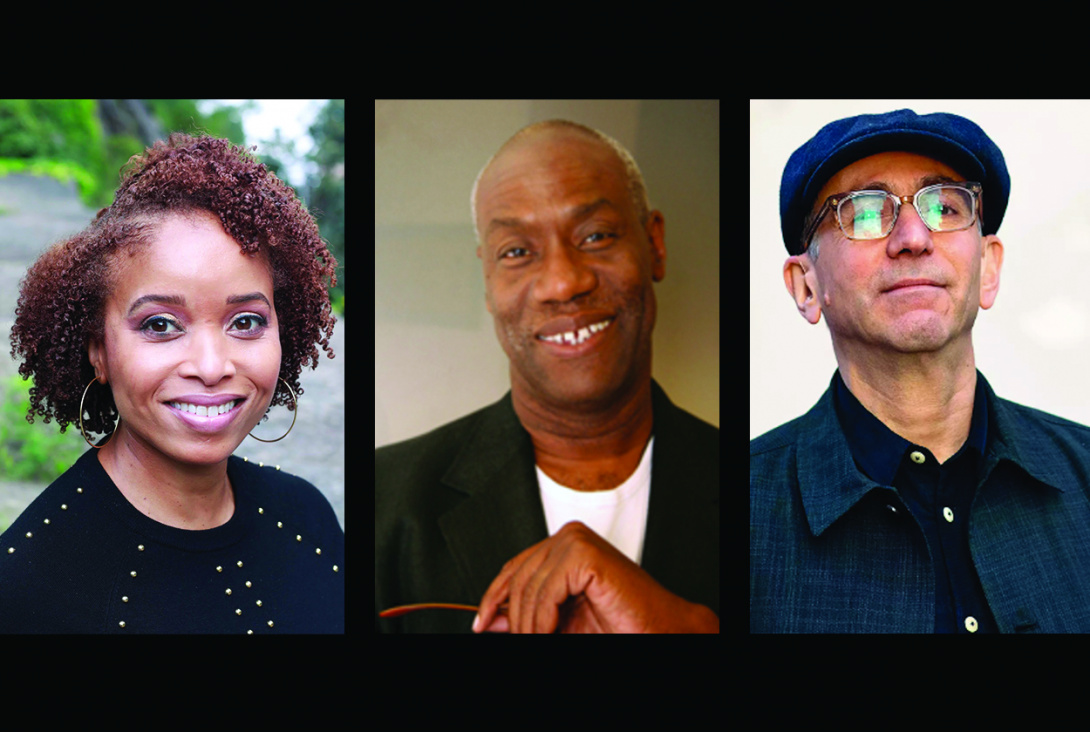
Courtesy of UC Santa Cruz Institute of the Arts and Sciences.
This event brings together visual and cultural theorists Nicole Fleetwood, Herman Gray and Nicholas Mirzoeff to consider the roles of visual culture in normalizing mass incarceration and the racist brutalities of policing within the social landscape and political vision of America. Questions of visuality and formations move beyond critiques of film, television, advertisements, and other media to ask how dominant visions of the world—and the visual regimes that regulate what people see and what remains hidden from view—are materialized in the prison industrial complex.
About the Visualizing Abolition series:
This program is part of a series of virtual talks and events presented in conjunction with the exhibition Barring Freedom, co-organized by SJMA and UC Santa Cruz Institute of the Arts and Sciences (IAS). The online events feature artists, activists, scholars, and others united by their commitment to the vital struggle for prison abolition and are coordinated by the IAS in collaboration with Professor Gina Dent, feminist studies, UC Santa Cruz.About the Speakers
Nicole Fleetwood is a writer, curator, and professor of American Studies and Art History at Rutgers University, New Brunswick. She is the author of Marking Time: Art in the Age of Mass Incarceration (Harvard University Press, 2020), On Racial Icons: Blackness and the Public Imagination (Rutgers University Press, 2015), and Troubling Vision: Performance, Visuality, and Blackness (University of Chicago Press, 2011). Fleetwood has curated exhibitions and events on art and mass incarceration at MoMA PS1, Andrew Freedman Home, Aperture, Cleveland Public Library, Zimmerli Art Museum, Mural Arts Philadelphia, Eastern State Penitentiary Historic Site, and the Urban Justice Center.
Herman Gray is Emeritus Professor Gray of Sociology at UC Santa Cruz where he taught graduate and undergraduate courses in media and television studies, cultural theory and politics and Black cultural studies. Gray has published widely in scholarly journals like American Quarterly, International Journal of Communication, Cultural Studies and Communication and Critical/Cultural Studies, and Television and New Media in the areas of black cultural politics, media and television studies. His books on jazz, television, and black cultural politics include Producing Jazz, Watching Race, and Cultural Moves. He co-edited Toward a Sociology of the Trace with Macarena Gomez Barris and The Sage Handbook of Television Studies with Toby Miller and Milly Buonanno. His most recent book is co-edited with Sarah Banet Weiser and Roopali Mukherjee called Race, Post Race published by Duke University Press.
Nicholas Mirzoeff is a visual activist, working at the intersection of politics, race and global/visual culture. In 2020-21 he is ACLS/Mellon Scholar and Society fellow in residence at the Magnum Foundation, New York. Among his many publications, The Right to Look: A Counterhistory of Visuality (2011); How To See The World (2015/16); and The Appearance of Black Lives Matter (2017/18). Since the 2017 events Charlottesville, he has been active in the movement to take down statues commemorating settler colonialism and/or white supremacy and convened the collaborative syllabus All The Monuments Must Fall, fully revised after the 2020 events. He curated “Decolonizing Appearance,” an exhibit at the Center for Art Migration Politics (September 2018-March 2019). A frequent blogger and writer, especially for the art magazine Hyperallergic, his work has appeared in the Nation, the New York Times, Frieze, the Guardian, Time, and The New Republic.
Visualizing Abolition is organized by UC Santa Cruz Institute of the Arts and Sciences in collaboration with San José Museum of Art and Mary Porter Sesnon Art Gallery. The series has been generously funded by the Nion McEvoy Family Trust, Ford Foundation, Future Justice Fund, Wanda Kownacki, Peter Coha, James L. Gunderson, Rowland and Pat Rebele, Porter College, UCSC Foundation, and annual donors to the Institute of the Arts and Sciences.
Partners include: Howard University School of Law, McEvoy Foundation for the Arts, Jessica Silverman Gallery, Indexical, The Humanities Institute, University Library, University Relations, Institute for Social Transformation, Eloise Pickard Smith Gallery, Porter College, the Center for Cultural Studies, the Center for Creative Ecologies, and Media and Society, Kresge College.